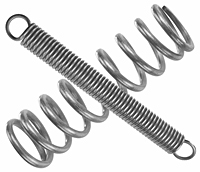
It’s not just the material that affects the performance of coil springs; the wire diameter is equally important.
Whether it’s a compression spring or an extension spring, its wire diameter will affect its performance. Some springs are thicker than others. They are made of thicker wire, resulting in a larger diameter. The wire diameter can affect a spring’s performance in several ways.
Spring Rate
There’s a correlation between the wire diameter of a spring and its spring rate. Also known as spring constant, spring rate represents the amount of force needed to compress or extend a spring by 1 inch. You can use it to determine the stiffness of a spring. The higher the spring rate, the stiffer the spring.
Springs with a thick wire diameter typically have a higher spring rate than those with a thinner wire diameter. And even a small increase in the wire diameter can have a big impact on spring rate. The relationship between these two properties is exponential. If you double the wire thickness of a spring, its spring rate may increase by as much as 16 times.
Load Capacity
If you’re looking for a spring that can handle a lot of force — either pulling or compression force — you should choose a spring made of thick wire. The wire diameter of a spring will affect its load capacity.
A thick wire diameter will allow the spring to handle heavier loads. This is why most heavy-duty springs, such as those used in machinery and vehicles, are made of thick wire. Springs with a thinner wire diameter are lighter and smaller but may fail when exposed to excessive force.
Durability
The wire diameter of a spring will affect its durability. Springs made of thick wire are typically more durable and resistant to fatigue than those made of thinner wire.
Springs can become weaker over time. The constant compressing or extending can wear them down, resulting in a lower spring rate. A thick wire diameter, however, will protect springs from fatigue such as this.
Size
Of course, the wire diameter of a spring will affect its size. The wire diameter represents the thickness of a spring. The thicker the wire diameter, the bigger the spring and the more space it will take up.
It’s important to note that springs have an inner diameter and an outer diameter. The inner diameter is the width from the inner edge of the wire coil to the opposite inner edge. The outer diameter is the width from the outer edge of the wire coil to the opposite outer edge. The difference between the inner and outer diameter is the actual wire diameter.
